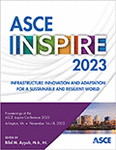Assessing Nature-Based Coastal Flood Risk Management Measures in Back Bay Environments
Publication: ASCE Inspire 2023
ABSTRACT
Evidence suggests natural and nature-based features (NNBFs) such as coastal wetlands and islands can reduce maximum water levels during storms but the efficacy of these measures is highly variable. Combined storm surge and wave modeling results are presented to (1) quantify the effects of coastal wetlands on current and future water levels for frequent events; (2) determine how coastal wetland management can be used to minimize wetland degradation; and (3) simulate potential wave attenuation benefits of small targeted NNBF designs. Wave attenuation accounted for the majority of water level reduction and NNBF elevation was correlated with wave attenuation benefits. Minimal levels of coastal wetland management reduced wetland loss and lowered water levels compared to no-action. Limited sediment resources should be targeted towards to the most vulnerable areas of the back bay to optimize wave attenuation benefits of existing wetlands into the future.
Get full access to this article
View all available purchase options and get full access to this chapter.
REFERENCES
ADCIRC. (2022). ADCIRC Utility Programs, http://adcirc.org/home/related-software/adcirc-utility-programs/, accessed on June 10, 2022.
Al-Attabi, Z., Xu, Y., Tso, G., and Narayan, S. (2023). The impacts of tidal wetland loss and coastal development on storm surge damages to people and property: a Hurricane Ike case-study. Scientific Reports, 13(1), 4620.
Anderson, M. E., and Smith, J. M. (2014). Wave attenuation by flexible, idealized salt marsh vegetation. Coastal Engineering, 83, 82–92.
Cialone, M. A., et al. North Atlantic Coast Comprehensive Study (NACCS) coastal storm model simulations: Waves and water levels. Engineer Research and Development Center, Vicksburg, MS Coastal and Hydraulic Laboratory, 2015.
Currin, C. A., Davis, J., and Malhotra, A. (2017). Response of salt marshes to wave energy provides guidance for successful living shoreline implementation. Living Shorelines, 211–234.
Ganju, N. K., Defne, Z., and Fagherazzi, S. (2020). Are elevation and open‐water conversion of salt marshes connected? Geophysical Research Letters, 47(3), e2019GL086703.
Ganju, N. K., Defne, Z., Kirwan, M. L., Fagherazzi, S., D’Alpaos, A., and Carniello, L. (2017). Spatially integrative metrics reveal hidden vulnerability of microtidal salt marshes. Nature communications, 8(1), 14156.
Leonardi, N., Carnacina, I., Donatelli, C., Ganju, N. K., Plater, A. J., Schuerch, M., and Temmerman, S. “Dynamic interactions between coastal storms and salt marshes: A review.” Geomorphology 301 (2018): 92–107.
Lopez, J. A. “The multiple lines of defense strategy to sustain coastal Louisiana.” Journal of Coastal Research (2009): 186–197.
Luettich, R. A., Jr., Westerink, J. J., and Scheffner, N. W. (1992). ADCIRC: An advanced three-dimensional circulation model for shelves, coasts, and estuaries., US Army Engineer Research and Development Center, Vicksburg, MS.
Massey, T. C., Anderson, M. E., Smith, J. M., Gomez, J., and Jones, R. (2011). STWAVE: Steady-state spectral wave model user’s manual for STWAVE, version 6.0. US Army Engineering Research and Development Center, Vicksburg, MS.
Morris, J. T., et al. (2016). Contributions of organic and inorganic matter to sediment volume and accretion in tidal wetlands at steady state. Earth’s future, 4(4), pp.110–121.
Nadal-Caraballo, N. C., Melby, J. A., Gonzalez, V. M., and Cox, A. T. (2015). “Coastal storm hazards from Virginia to Maine.”, US Army Engineer Research and Development Center, Vicksburg, MS.
Narayan, S., Beck, M. W., Wilson, P., Thomas, C. J., Guerrero, A., Shepard, C. C., Reguero, B. G., Franco, G., Ingram, J. C., and Trespalacios, D. “The value of coastal wetlands for flood damage reduction in the northeastern USA.” Scientific reports 7, no. 1 (2017): 1–12.
SAB Work Group. (2020). The status and future of tidal marshes in New Jersey faced with sea level rise.
Slusarczyk, G., Cialone, M. A., Nadal-Caraballo, N. C., and Hampson, R. W. (2020). In preparation. Numerical Storm Surge Modeling and Statistics for Evaluating Proposed New Jersey Back Bays Inlet Closures.
van Berchum, E. C., Mobley, W., Jonkman, S. N., Timmermans, J. S., Kwakkel, J. H., and Brody, S. D. “Evaluation of flood risk reduction strategies through combinations of interventions.” Journal of Flood Risk Management 12, no. S2 (2019): e12506.
Westerink, J. J., Blain, C. A., Luettich, R. A., Jr., and Scheffner, N. W. (1994). ADCIRC: An Advanced Three-Dimensional Circulation Model for Shelves, Coasts, and Estuaries – Report 2 User’s Manual for ADCIRC-2DDI., US Army Engineer Research and Development Center, Vicksburg, MS.
Zapp, S. M., and Mariotti, G. (2021). Evaluating direct and strategic placement of dredged material for marsh restoration through model simulations. Shore & Beach, 89(4), 33.
Information & Authors
Information
Published In
History
Published online: Nov 14, 2023
ASCE Technical Topics:
- Bays
- Coastal engineering
- Coastal processes
- Coasts, oceans, ports, and waterways engineering
- Environmental engineering
- Fluid mechanics
- Hydrologic engineering
- Sea water
- Shores
- Storm surges
- Stormwater management
- Water (by type)
- Water and water resources
- Water level
- Water management
- Water supply
- Water treatment
- Wave attenuation
- Waves (fluid mechanics)
- Wetlands (coastal)
Authors
Metrics & Citations
Metrics
Citations
Download citation
If you have the appropriate software installed, you can download article citation data to the citation manager of your choice. Simply select your manager software from the list below and click Download.
